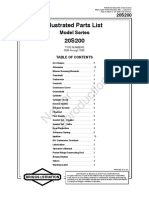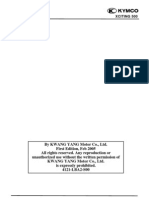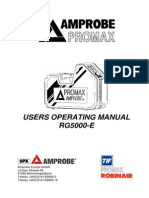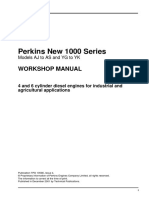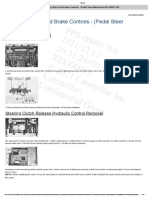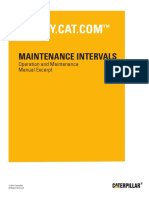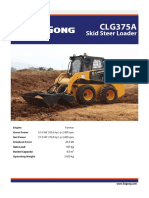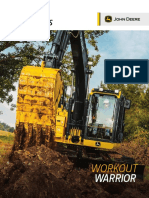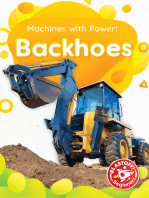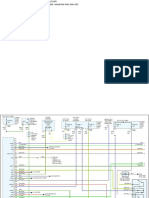Atkinson Tractor Service Shop Manual Unit 1 - Engine and Ancilliary Equipment
Atkinson Tractor Service Shop Manual Unit 1 - Engine and Ancilliary Equipment
Uploaded by
David KellyCopyright:
Available Formats
Atkinson Tractor Service Shop Manual Unit 1 - Engine and Ancilliary Equipment
Atkinson Tractor Service Shop Manual Unit 1 - Engine and Ancilliary Equipment
Uploaded by
David KellyOriginal Description:
Copyright
Available Formats
Share this document
Did you find this document useful?
Is this content inappropriate?
Copyright:
Available Formats
Atkinson Tractor Service Shop Manual Unit 1 - Engine and Ancilliary Equipment
Atkinson Tractor Service Shop Manual Unit 1 - Engine and Ancilliary Equipment
Uploaded by
David KellyCopyright:
Available Formats
Unit: 1
Section: 0
SERVICE SHOP MANUAL
Page: 1*
Date: January, 1970
UNIT 1
ENGINE AND ENGINE ANCILLARY EQUIPMENT
I ndex of Contents
Section
Technical Data
lA
Engine Removal and Replacement 2A
Air Filter 3A
Cooling System 4A
Fuel System 5A
Exhaust System 6A
Accelerator Gear 7A
Ancillary Equipment SA
Engine Mountings 9A
Note: For comprehensive engine servicing and overhaul instructions refer to the appropriate engine manufacturers
publication.
Index of Contents
Gardner Engines
Cummins Engines
Rolls-Royce Engines
SERVICE SHOP MANUAL
UNIT 1
ENGINE AND ANCILLARY EQUIPMENT
SECTION 1A
TECHNICAL DATA
Unit: 1
Section: 1A
Page : 1
Date: January, 1970
Page
2
It
6
unit: 1
3ection: 1A
:lage:
2
SERVICE SHOP MANUAL
)ate:January, 1970
GARDNER ENGINES
Two types of Gardner engines are used and both are compression-ignition, vertical in-line, natural asperated, water
cooled power units.
Type
Number of cylinders
Bore
Stroke
Maximum bhp
Rev/ min of maximum bhp
Maximum torque
Rev/ min of maximum torque
Capacity
Firing order
Crankshaft rotation
Compression ratios
Valves and Valve Timing
Tappet clearance (cold) - Inlet valves
Exhaust valves
Angl e of valve faces and valve seats
Timing Clearance (inlet and Exhaust valves)
Decompression: Lift of inlet valves
Valve timing : Inlet valve opens
Exhaust valve closes
Governor
Idling speed setting
Maximum governed no-load speed
Governor spring load at maximum rev/min
Fuel System
Fuel injection timing
Fuel lift pump pressure
Fuel filter frame mounted
6LX
150
1700
485 Ibf ft
(67kgfm)
6LXB
6
4.75 in (121 mm)
6.00 in (152.4 mm)
1050
180
1800
536 Ibf ft
(14 kgf m)
638 in
3
(10.45 litre)
1, 5, 3, 6, 2, 4
Anti-clockwise viewed from flywheel end.
14 to 1
0.004 in (0.102 mm)
0.011 in (0.279 mm)
45 degrees 30 degrees
0.020 in (0.508 mm)
0.020 in (0.508 mm)
11 degrees b.t.d.c. 16.25 degrees b.t.d.c.
11 degrees a.t .d.c. 11.75 degrees a.t.d.c.
Note: The above settings are with tappet
clearance of 0.020 in (0_508 mm) and the
timing chain tight_
1 760 rev/min
107 Ib
(48.5 kg)
420 rev/min
30 degrees b.t.d.c.
at 1 700 rev /min
1.5lbf/in
2
(0.105 kgf/cm2)
Paper element type
1 980 rev/min
130lb
(58.9 kg)
31 degrees b.t.d.c.
at 1 850 rev/min
Unit: 1
Section: lA
SERVICE SHOP MANUAL
Page:
3
Lubrication System
Oil pressure
. Oil Temperature
Oil Sump capacity
Lubricating oil specification
Cooling System
Coolant temperature (outlet)
Thermostat opening temperature
Water Capacity
Air Filter
Type
Thermostat
Code No.
TH2001/00/68
TH2001/00/59
Crack open
Temperature
68 degrees C (153 degrees F)
59 degrees C (137 degrees F)
Date: January, 1970
35lbf/in
2
(2.5 kgf/cm) at 1 000 rev/min
60 degrees C (140 degrees F)
39 pints (22.2 litre)
See Gardner engine manual and Unit 0,
Lubricants and Fluids of this manual
61 degrees C (142 degrees F)
Smith's Bellows Type Thermostat
Fully open
Temperature
87 degrees C (188 degrees F)
78 degrees C (172 degrees F)
9 gallon (41 litre)
Coopers 12 in FWG, paper element type with
air cleaner restriction indicator.
Jnit: 1
;ection: 1A
)age:
SERVICE SHOP MANUAL
)ate: January, 1970
CUMMINS ENGINES
Two types of Cummins engines are used and both are compression-ignition, vertical in-line, natural asperated, water
cooled power units_
Type
Number of Cylinders
Bore
Stroke
Maximum b.h.p.
Rev/min of maximum b.h.p.
Maximum torque
Rev/min of maximum torque
Capacity
Firing order
Crankshaft rotation
Compression ratio
Engine idling speed
Valves and Injector Plunger Adjustment
Tappet clearance:
Inlet
Exhaust
Tappet locknut torque
Injector plunger adjustment torque
I nj ector plunger locknut torque
Fuel System
Fuel injection timing
Fuel filter frame mounted
Lubrication System
Oil pressure
NHK 180
205
560 Ibf ft
(77.4 kgf m)
1350
1, 5, 3, 6, 2, 4
NHK 220
6
5_125 in (130 mm)
6_00 in (152 mm)
2100
220
605 Ibf ft
(84 kgf m)
1400
143 in
3
(12.17 litre)
Anti-clockwise viewed from flywheel end
15.6 to 1
525 to 620 rev/min
0.016 in at 21 degrees C (70 degrees F) oil temperature (Cold)
0.014 in at 60 degrees C (148 degrees F) oil (Hot)
0.029 in at 21 degrees C (70 degrees F) oil temperature (Cold)
0.027 in at 60 degrees C (140 degrees F) oil temperature (Hot)
70 to 80 Ibf ft
48 Ibf in at 21 degrees C (70 degrees F) oil temperature (Cold)
60 Ibf in at 60 degrees C (140 degrees F) oil temperature (Hot)
70 to 80 Ibf ft
12 degrees b.t.d.c. 5 degrees b.t.d.c.
Paper element type
5 to 20 Ibf/in2 at idling speed
30 to 70 Ibf/in2 at rated speed
Note: Individual engines may vary from the above normal pressures. Observe and record pressures when engine is new
to as a ouide for indication of proqressive enqine condition.
SERVICE
Oil Sump Capacity
Lubricating oil specification
Cooling System
Thermostat opening temperature
Water capacity
Air Filter
Type
SHOP MANUAL
33 pints (18.7 litre)
See Cummins engine manual and Unit 0,
Lubricants and Fluids of this manual.
78 degrees C (170 degrees F) crack open
85 degrees C (185 degrees F) fully open
9 gallon (41 litre).
Unit: 1
Section: 1A
Page:
5
Date: January, 1970
Coopers 12 in FWG Cycolpac. Dry element with air
cleaner restriction indicator.
Unit: 1
Section: 1A
Page: 6
SERVICE SHOP MANUAL
1970
ROLLS-ROYCE ENGINES
Two types of Rolls-Royce engines are used and both are compression-ignition, vertical in-line, natural aspirated, water
cooled power units.
Type
No. of Cylinders
Bore
Stroke
Maximum b.h.p.
Rev/min of maximum b.h.p.
Maximum torque
Rev/min of maximum torque
Capacity
Firing order
Crankshaft rotation
Compression ratio
Valves and valve timing
Tappet clearance (engine stopped, hot or cold):
Inlet valves
Exhaust valves
Valve Timing: Inlet valve opens
Inlet valve closes
Exhaust valve opens
Exhaust valve closes
Angle of valve faces and valve seats
Engine Idling speed
Fuel System
Fuel inj ection timing
Fuel injection pressure
Fuel lift pump pressure at engine idling speed
Fuel filter frame mounted
Lubrication System
Oil pressure
Eagle 205
6
5.125 in (130.175 mm)
205
560 Ibf ft
(77.4 kgf m)
1350
6.00 in (152.4 mm)
2100
742.64 in
3
(12.17 litre)
1, 4, 2, 6, 3, 5
Anti -clockwise viewed from flywheel end
16 to 1
0.010 in (0.25 mm)
0.015 in (0.38 mm)
12 degrees b.t.d.c.
50 degrees a.b.d.c.
60 degrees b.b.d.c.
19 degrees a.t.d.c.
45 degrees
550 to 600 rev/min
As stamped on engine data plate
240 atmosphere
10 to 12 Ibf/in2 (0.7 to 0.85 kgf/cm2)
Purolator metal edge types,
Eagle 220
220
605 Ibf ft
(84 kgf m)
55 to 75 Ibf/in
2
(3.8 to 5.2 kgf/cm2) normal.
30lbf/in
2
(2.1 kgf/cm2) minimum for continuous
Unit: 1
Section: 1A
SERVICE SHOP MANUAL
Page :
7*
Filters
Oil sump capacity
Lubricating oil specification
Cooling System
Temperatures
Water capacity
Air Filter
Type
Two full flow, expendable elements.
52 pints (29.5 litre)
See Rolls-Royce engine manual and Unit 0,
Lubricants and Fluids of this manual.
Note: Multigrade oils are not approved_
Date :J anuary , 1970
80 to 100 degrees C (176 to 212 degrees F) norma I.
107 degrees C (225 degrees F) maximum.
10 gallon (45.5 litre)
Coopers 12 in FWG Cycolpac. Dry element with
air cleaner restriction indicator.
Index of Contents
Technical Description
Routine Maintenance
Drive Belt Adjustment
Drive Belt Maintenance
Frost Precautions
SERVICE SHOP MANUAL
UNIT 1
ENGINE AND ANCILLARY EQUIPMENT
SECTION 4A
COOLING SYSTEM
for
MARK II VEHICLES
Cooling System To Drain and Refill
To Flush Clean the Cooling System
Unit Replacement:
Radiator to Remove and Refit
Note: For comprehensive servicing and overhaul instructions for the Cooling System refer
to the appropriate engine manufacturer's publications.
Unit: 1
Section: 4A
Page:
1
Date: January, 1970
Page
2
2
2
7
7
8
9
10
Unit: 1
Section: IrA
Page:
2
SERVICE SHOP MANUAL
DaM: January, 1970
TECHNICAL DESCRIPTION
On all engine applications the cooling system and piping
layout are similar and differ only in the top and bottom
radiator pipe connections as can be seen in Figs. 2, 3 and
4.
The cooling cycle is of the thermo-syphon type with
centrifugal water pump assistance. In the case of
Gardner engined vehicles the water pump is shaft driven
while on Cummins and Rolls-Royce powered vehicles
the pump is belt driven.
Adequate means are provided to obviate air pockets in
the radiator top tank and in the engine during the initial
filling operation and during service conditions, by the
use of an expansion pipe connected between the radiator
top tank and the header tank on the cab back. A bleed
screw is also positioned in the top radiator water pipe
for de-aerating purposes.
A thermostat fitted in the engine enables the correct
working temperature to be reached in the shortest
possible time.
The thermostat valves seals the outlet to the radiator
while the coolant is cold, but allows it to circulate
through the block and cylinder heads until the crack
opening temperature is reached, when the valve opens
and brings the radiator into full operation when the
valve is fully open.
Coolant drawn by the water pump from the bottom
tank of the radiator, is circulated through the engine
block and cylinder heads, and back to the top tank of
the radiator, where it is cooled as it flows through the
radiator by air drawn through the cooling stack by the
fan.
ROUTINE MAINTENANCE
First 1 500 Mile (2 400 km) of a new Vehicle
Or the fitment of Replacement Parts
1. Check fan drive belts tension and adjust if
necessary.
2. Examine all hoses, connecting tubes, clips and
unions for soundness and leakage.
3. Check security of radiator mountings.
Daily Inspection
Remove header tank filler cap and check the level of the
coolant. If topping-up is required be sure to use clean
water and in winter use a ready mixed solution of
anti-freeze to the specification quoted in Unit 0, Section
5 of this manual.
Note: Avoid if possible the use of hard water in the
cooling system, as this will deposit lime in the
hottest parts of the engine cooling jacket and in
restricted passages, causing cracks in the former and
interfering with the circulation in such places as the
thermostat and radiator tube blocks.
Monthly or Every 5 000 Mile (8000 km)
1. Examine radiator cores and tanks for leakage and/or
damage and rectify if necessary.
2. Examine all hoses for deterioration and renew if
necessary.
3. Check tightness of all water pipe clips and unions.
4. Check drive belt tension and adjust if necessary.
5. I nspect fan assembly for correct clearance, bent or
broken blades.
Two Monthly or Every 10000 Mile (16000 km)
1. Cummins engines only. If fitted renew corrosion
resistor element.
Three Monthly or Every 15 000 Mile (24000 km)
1. Gardner engines only. Lubricate radiator fan spindle
bearing with grease. Refer to Fig. 5.
Six Monthly or Every 30000 Mile (48 000 km)
1. Drain and flush out the cooling system.
2. Remove, clean and test the engine thermostat.
3. Carefully inspect the fan drive belts for wear and/or
cracks and replace if necessary.
4. Examine for play in fan and for leaks in water pump
gland seal.
5. Examine flanged water joints for leaks and check
cylinder head nuts for tightness. Leakage of coolant,
particularly an anti-freeze mixture, past the cylinder
head gaskets may result in a 'gummed-up' engine
resulting in expensive repairs.
Yearly or Every 50 000 i l ~ (80 000 km)
1. Gardner engine only. Lubricate water pump spindle
bearing with one grease cup full of grease.
DRIVE BELT ADJUSTMENT
The tension of the drive belts should be checked and
adjusted at the times or mileages quoted under Routine
Maintenance of this section, by pressing the belts
midway between the pulleys on the longest run of the
belts.
Unit: 1
Section: itA
SERVICE SHOP MANUAL
Page :
7
The method of belt adjustment varies with different
engines and the engine manufacturer's manual should be
referred to.
Belt deflection should be maintained at:
Gardner engine - 1.0 in (25.4 mm)
Cummins engines - 0.43 in (11.1 mm) per foot of span
Rolls-Royce engines - 0.5 in (12.7 mm)
Over-tensioning should be avoided, as it will be just as
harmful as slackness and will overload the bearings in
such places as the water pump and alternator.
DRIVE BELT MAINTENANCE
It is important that routine inspection of the drive belts
is maintained, since during service, stretch and wear will
take place causing slackness. If this is allowed to become
excessive it will result in rapid deterioration and eventual
drive belt failure.
When renewing drive belts, if twin or triple belts are
fitted all must be renewed as they are part of a complete
set.
A point which is often overlooked when carrying out
drive belt maintenance or replacement is to check the
pulleys for wear. Badly worn pulleys will reduce the life
of the drive belts just as much as excessive slackness.
They should not be allowed to wear to the extent that
the belts bottom on the pulley grooves.
A drive belt often slips or squeaks because of glazing of
the drive surface due to dirt or steam cleaning.
To clean a belt wipe it thoroughly with an approved belt
lubricant. Cleaning in this manner will eliminate most
cases of squeaking.
Do not tighten a belt beyond the recommended setting
figure to eliminate squeak. Squeak does not necessarily
mean belt slippage.
FROST PRECAUTIONS
In order to provide full protection against damage due to
frost the cooling system should be drained completely,
flushed out, and refilled with fresh water and anti-freeze
solution in the proportion of three parts of water to one
part of anti-freeze, or as recommended by the
manufacturer, and at the same time all hose clips and
connections should be tightened so as to ensure that no
leakage occurs.
If topping up is necessary in a cooling system which has
had anti-freeze solution introduced it is essential that a
mixture of water and anti-freeze solution in the correct
proportions should be used so as to avoid weakening the
mixture and thus reducing its effectiveness.
Date: January, 1970
Vehicles with anti-freeze mixture in the cooling system
should have a notice displayed in the cab stating
'Anti-freeze. Do not Drain'.
Anti-freeze should not be used in the cooling system any
longer than is necessary, when climatic conditions
become temperate it is recommended that the cooling
system be drained and thoroughly flushed with clean
water to remove all traces of the anti-freeze mixture.
Use only anti-freeze conforming with the specification
quoted in Unit 0, Section 5 of this manual.
If an anti-freeze solution is not in use and the vehicle is
to remain standing in the open with t emperatures
approaching or at freezing point, the cooling system
must be drained completely.
After draining place a 'Cooling System Drained' noti ce
on the steering wheel or similar conspicuous pl Cl ce.
FIG.5. GARDNER FAN HUB AND WATER
PUMP LUBRICATOR
1. Fan hub lubricator 3. Belt adjusting screw
2. Water pump lubricator 4. Fan spindle locknut
Jnit: 1
;ection: 4,A
'age: 8
late: J a nuary ,
SERVICE SHOP MANUAL
1970
COOLING SYSTEM TO DRAIN AND REFILL
To Drain System
1. The cooling system main drain tap is located in the
bottom water pipe from the engine to the radiator.
On Gardner engines an additional drain tap is fitted
in the base of the water pump housing.
On Rolls-Royce engines additional drain taps are
fitted, one in the engine block directly above the
starter motor and one in the heat exchanger water
inlet pipe.
On Cummins engines to completely drain the
engine, open the drain tap or remove the drain plug
on the manifold side of the cylinder block at the
rear of the engine together with the drain plug in
FIG. 6. VIEW OF COOLING SYSTEM the Corrosion Resistor bowl. .
MAIN DRAIN TAP
FIG.7. TYPICAL VIEW OF ROLLS-ROYCE
REAR ENGINE DRAIN TAP
2. Before drainage, start the engine and run until the
coolant temperature reaches approximately normal.
Stop the engine, remove filler cap and open the
drain taps and remove drain plugs as applicable, as
soon as possible to drain the coolant whilst any
sediment in the system is still in suspension.
3. When drainage is complete close the drain taps and
refit drain plugs as applicable.
To Refill
Refer to Figs. 9 and 10
1. When refilling the cooling system special
precautions are necessary to ensure that the system
is fully primed and that no air pockets remain in the
water passages.
2. The entire cooling system is filled from the header
tank on the cab back.
1. Drai n t ap 2. Accelerator linkage
FIG.8. GARDNER ENGINE DRAIN
TAP ON WATER PUMP
1. Water pump 2. Dr ain tap
3. On Cummins engines open the air bleed tap on the
thermostat housing, while on Gardner and
Rolls-Royce engines open the air bleed tap on the
top water gallery. .
Note: If no air bleed tap is fitted slacken off the
capillary in the top water gallery.
4. Commence to fill the system until a steady flow of
air free coolant is present at the air bleed point.
5. Start the engine and before closing the engine air
bleed point check for further air expulsion from this
point.
6. Keep the coolant level in the header tank just below
the expansion pipe union, open the air bleed top in
the radiator tap water pipe and continue to fill the
system until a steady flow of water is present at this
point before closing the tap.
.------------------------------- - ---------------------- ----
Unit: 1
Sect ion : 4A
SERVICE SHOP AJl
Page:
9
Note: If the water level is allowed to rise above the
level of the expansion pipe union in the header
tank, air trapped in the radiator top tank will not be
allowed to escape to the header tank and
atmosphere via the vent hole in the filler cap.
7. Run the engine for a short time at half throttle to
ensure that the coolant level is constant then refit
the filler cap.
Note: The cab heater water flow control valve should
be in the fully open position during the drainage
and refilling procedure.
TO FLUSH CLEAN THE COOLING SYSTEM
For periodic cleaning, flush thoroughly with clean water
until it runs clean from the drain taps.
If the system is badly contaminated a suitable cooling
system cleaning solvent should be used.
Clean the system in the following manner:
Use warm water for flushing or refilling the cooling
system of a warm engine.
1. Drain cooling system low enough to add correct
quantity of cleaning solvent.
2. Start the engine and warm up to nearly normal
running temperature with a fast engine speed.
3. Stop the engine and drain the system immediately,
before any sediment can settle.
4. Allow the system to cool down, then refill with
clean water, allowing a gallon or more to run to
waste before closing the drain taps.
5. Re-run the engine up to normal operating
temperature again, then re-drain the system and
flush out until clean water runs out of the drain
taps.
6. Close all drain taps and refill the system in the
normal way.
TROUBLE SHOOTING
Listed below are some faults which cause overheating of
the cooling system:
1.
2.
3.
4.
5.
6.
7.
Insufficient coolant in system.
Slipping or broken drive belts.
Partially or blocked radiator.
Obstructed air flow through radiat or.
Faulty thermostat.
Excessive air locks in system.
Faulty water pump.
Date: Januar y , 197(
I
\ii' ..
FIG. 9. CUMMII\I S ENGINE AI R BLEED TAP
1. Air bleed t ap 2. Thermostat housing
FIG. 10. IlAOIATOI1 AIR BLEED TAP
1. Ai r bleed t ap 2. Top water hose
8. Incorrect injec ti oll limi ny.
9. Leaks in sys lem.
10. Excessive carbon deposits in cylinder heads.
11. Worn or fault y oi l 1J1I1np.
Overheat ing is usually il ld icalcd by loss or boi li ng
cool ant in such circumsliJ nces, Il ever top-up the system
right away wi t h cold wa ter as t he sudden change of
temperat ure may crack the cylinder heads and/or
cylinder block . Al ways all ow the engine to cool down
.fi rr+
Jnit: 1
:; ection : itA
:>age : 10*
)Me: J a nuary , 1970
a
o
""
SERVICE
I
SHOP MANUAL
UNIT REPLACEMENT
Radiator to Remove and Replace
To Remove
1. Drain cooling system.
2. Remove the front bumper bar and radiator grill e.
On certain applications it may al so be necessary to
remove the radiator grille surround.
3. Disconnect the expansion pipe from the radiator
top tank and the top water hose from the engine
connection pipe.
4. Disconnect the bottom water hose from the engine
connection pipe.
5. On Gardner engines if an oil cooler is fitted
disconnect the necessary piping.
FIG. 11 . RADIATOR MOUNTING BOLT
6. Remove the two 0.5 in B.S. F. bolts from the
radiator side pressings and collect the rubber blocks
and plain washers from between the radiator and
side stay brackets. The radiator will now tilt
forwards on its foot hinges.
1. Bolt 3. Rubber block
2. Plain washer 4. Side stay
FI G.12. RADIATOR FOOT HINGE
1. Foothinge 2. Bolt
7. Support the radiator and remove the bolts from the
foot hinges. The radiator can now be withdrawn
from the vehicle.
To Refit
Replacement of the radiator is a reversal of the removal
procedure ensuring that the metalastik bushes in the
foot hinges are in good condition and that the rubber
blocks are replaced between the side stay brackets and
radiator side pressings.
SERVICE SHOP MANUAL
UNIT 1
ENGINE AND ANCILLARY EQUIPMENT
SECTION 5A
I ndex of Contents
Technical Description
Fuel Tank:
Maintenance
Removal and Replacement
To Repair a Leaking Fuel tank
Fuel Filter (Paper Element Type):
Technical Description
Maintenance
To Replace the Filter Element
Fuel Filter (Metal Element Type):
Technical Description
Maintenance
Unit Replacement
Unit Overhaul:
To Dismantle filter
Cleaning and Inspection
of Dismantled parts
To Re-assemble filter
Testing Overhauled filter
FUEL SYSTEM.
Unit: 1
Section: 5
A
Page: 1
DMe:January, 1970
Page
2
2
2
2
2
3
3
4
4
4
5
5
6
6
Note: For comprehensive servicing and overhaul instructions for the engine fuel system refer to the appropriate engine
manufacturers service manual.
'nit: 1
ection: ')A
'age: 2
SERVICE SHOP MANUAL
late: January, 1970
TECHNICAL DESCRIPTION
As various types of engines are fitted in this range of
vehicles the fuel system dealt with in this section covers
the system only from the fuel tank to engine mounted
fuel feed pump, For detailed instructions on the fuel
system from the fuel feed pump, reference should be
made to the appropriate engine manufacturers service
publication.
The fuel system from the tank, which is normally
mounted on the left-hand chassis frame side member,
incorporates a primary fuel filter which varies in design
depending on the type of engine fitted in the vehicle. On
Cummins or Gardner engined vehicles a paper element
type fil ter is employed while, on vehicles fitted with a
Rolls-Royce engine, a metal edged element type filter
with a mechanical hand cleaning mechanism is fitted.
FUEL TANK
The fuel tank of 54 gal. (296.5 litre) capacity is
cylindrical in shape and constructed from steel pressings,
and is secured to the left-hand frame side-member. An
additional tank of the same capacity may also be fitted.
The tank is fitted with a screw type filler cap and an
electric fuel gauge unit. A breather is also fitted in the
tank.
Maintenance
Very littl e attention is necessary for long periods, apart
from periodic checks to ensure that the breather is not
blocked and to ensure that the tank is securely mounted.
FIG. 1 FRAME MOUNTED FUEL FI L TER GARDNER
ENGINES
If trouble is experienced with dirty fuel oil due to
operating conditions, the tank(s) should be drained,
removed from the chassis and thoroughly cleaned out
with clean fuel oil to remove any foreign matter. If
water is present in the fuel, this should be filtered off by
draining through a very fine muslin.
To remove the Fuel Tank
1. Remove the sump plug and washer irom the bottom
of the tank and drain the fuel into clean containers.
2. Disconnect the fuel feed pipe and the fuel return
feed pipe from the tank unions.
Note: If dual tanks are fitted, disconnect the inter-tank
fuel pipe from the bottom of the tank.
3. Remove the rubber boot from the fuel tank gauge
unit and disconnect the wiring.
4. Remove the nuts from the tank fixing rods and lift
the rods clear of the tank.
5. Lift the tank clear of the mounting brackets.
To Re-fit the Fuel Tank
The re-fitting of the tank is a reversal of the removal
procedure, ensuring that the mounting bracket felts are
in good condition and that the sump plug is tight and
fitted with a washer.
To Repair a Leaking Fuel Tank.
Leaks in a fuel tank should be repaired by soldering.
However, before attempting to repair a tank it must be
thoroughly cleaned internally and all traces of fuel oil
removed. Whilst there is not the same danger of
explosion with a diesel tank as in the case of a petrol
supply tank, any traces of fuel oil left in the tank may
take fire when the tank is heated and carbon ash will be
formed which will contaminate the fuel on re-filling.
Internal cleaning is best performed by blowing high
pressure steam through the tank for a few minutes, but,
if this method is not practicable, boiling water may be
used.
Whatever method of cleaning is used care should be
taken to ensure that the tank is thoroughly dry before
any repair work is carried out and the tank refitted to
the vehicle.
FUEL FILTER (Paper element type).
Technical Description
The filter is of the cross-flow type, the inlet and outlet
connections being carried in the filter head which also
incorporates a mounting bracket. The filter bowl is made
of pressed steel and forms an oil tight container for the
paper element. A drain plug is fitted in the base of the
filter bowl to be drained prior to dismantling.
Unit: 1
Section: 5
A
SERVICE SHOP MANUAL
Page:
The fuel oil enters the filter t hrough the inlet connection
and passes down outside the element canister, then up
through the element and finally emerges via the central
outlet connection.
Dirty fuel oil is excluded from the clean side of the
element by means of oil seals at the top and bottom of
the element core, oil tightness of the seals being
maintained by a pressure spring at the base of the
element.
Maintenance
Paper type elements are not intended to be cleaned and
must be discarded when choked. The period or mileage
at which the filter element is changed is influenced by
the type of fuel used, cleanliness of the fuel supply and
system and local conditions under which the vehicle is
operating, all have a profound influence on the working
life of the filter element, but, under normal operating
conditions the element should be replaced every
5 000 mile (8 000 km).
The care in replacing the element and avoiding dirt on
the clean side of the filter, can not be too highly
emphasised, as many complaints of fuel pump element
wear can be traced to insufficient care in the servicing of
the filt ers. When choking of the filter element media
takes place, it is usually found to be due to a sludge
which is deposited from the fuel. If the filter is found to
be choked in a very short time this will probably
indicate an unsatisfactory fuel supply or storage tank
installation and steps shou ld be taken to find how, and
at what point, any excessive amount of foreign matter
can enter the fuel system.
The filter element may be tested for blockage by
disconnecting the fuel feed pipe from the fuel feed
pump to the engine mounted fuel filter and, by hand
priming the pump, observing the rate of fuel flow.
Alternatively, the filter element may be removed from
the filt er assembly and held in a vertical position, closing
the hole at the lower end by holding it down on a flat
surface and pouring fuel oil into the upper open end. If
the fu el collects and does not run through the filter
paper almost as quickly as it is poured in, the element is
probably blocked sufficiently to cause erratic running of
t he engine and should be replaced.
To Replace the Filter Element
Refer to Fig. 2.
1. Thorough ly clean the outside of the filter bowl and
head.
2. Slacken off the drain plug sufficiently for the drain
hole in the plug to be exposed for the fuel oil to
drain off from the bowl (the vent plug in the filter
head must also be slackened off).
3. Unscrew and remove the top cap nut to release the
filter bowl and withdraw the element from the
bowl. Discard the old element, no attempt should
be made to clean it for further use.
"0000
0
'
0000
00
____ 8
-12
DMe: January, 1970
FIG.2 EXPLODED VIEW OF PAPER ELEMENT
FUEL FILTER, GARDNER ENGINES.
1. Plug, air vent 10. Spring
2. Washer 11. Seal
3. Union 12. Bowl assembly
4. Nut 13. Washer
5. Union tail 14. Drain plug
6. Seal 15. Filter head
7. Element 16. Washer
8. Spindle seal 17. Head nut
9. Seal support plate
4. Remove the element lower seal, plate and spring
from the bowl together with the drain plug and
copper washer.
5. Remove the sealing ring and washer from the filter
head.
6. Thoroughly clean the filter bowl of all foreign
matter. Drain holes in the filter body base and drain
plug should be cleared by means of a fine wire.
Init: 1
;ection : 5A
'age:
SERVICE S HOP MANUAL
late: January, 1970
7. Examine the t op and ho t tom element seals and
replace wi th new ones if they show evidence of
deterioration, cuts or splits .
.8. Re-fit t he drain pl ug and copper washer t o the f il ter
bowl foll owed by the el ement retai ni ng spri ng,
lower seal support pl' l te and lower 5Cil l.
9. Fit a new papcr cl ement into ti l!! fi lter bowl and a
new sealing ri ng int o its l ocat ing groove i n the filter
head, f i rst ensuring t hat the ~ r o o v e is clean. A new
seali ng ri ng i s suppl ied wit h e8ch new element.
10. Fit the upper el ement seali nu r i llfj over t he el ement
l ocat i ng boss i n the filter head, gently rotating the
bowl so as to mini mi se the chance of foreign matter
causi ng an unsound j oi nt.
11 . Engage the washer and t.a p nu t wi th the centre stud
and screw up t ight . Undue f orce should not be
appl ied in an attempt to st op leakage. Ensure that
t he drain pl ug is t ight.
12. Operate the hand pr i ming lever of the f uel f eed
pump unti l ai r-fr ee oil appears f rom the vent plug in
the fil ter head, then ti ghten the pl ug foll owed by air
vent ing at the fuel i nj ect ion pump.
FIG.3 FRAME MOUNTED FUEL FILTER
ROL LS-ROYCE ENGI NES
1. Fuel pipe from t ank 3. Filter hand cl ean i ng wheel
2. Fuel pipe to engine 4. Sump dmi n plug
FUEL FILTER- METAL EDGED ELEMENT TYPE
WITH MECHANICAL HAND
CLEANING MECHANISM
Technical Description
The filter assembly comprises a body which has a filter
head bolted to it. A spindle with a hand wheel passes
through the filter head and supports a metal element
assembly. The element wire has a fl at f ront edge and
t apers in cross-section and is provi dc" wi t h equally
spaced projection the height of which are such that fuel
oil is allowed to pass to the outlet connection from t he
inside of the element. The t apered cross-section of I he
element wire makes it impossible for choking to take
pl ace behind the front edge.
A scraper blade, which forms part of the scraper
assembly is positioned in close proximity t o the el ement
and is retained on a spindle by screws.
In order to maintain an effective filter it is necessary t o
clean the element periodically, (the t ime interval
depending on operating conditions). Thi s is achi eved
without dismantling the filter by means of the hand
wheel. Turning it in a clockwi se direction, revolves the
element against the scraper blade which cuts away any
foreign matter adhered to it. The drain plug in the base
of the body should be removed periodically to drain off
t he foreign matter.
Maintenance
Apart from periodic cl eaning by turning the hand-wheel
and draining off any forei gn matter, which is governed
by local operating cond itions and experience, the filter
would not require dismantling before it has been in
service for approximately one year or 50 000 mil e
(80 000 km) whichever occurs first .
Unit Replacement
To Remove the Filter
1. Thoroughly clean the outside of the filter and the
surrounding area of the chassis frame before
disconnecting the fuel pipes.
2. Immediately after disconnecting the fuel pipes plug
the ends to prevent the ingress of any foreign
matter.
3. Remove the filter head mounting bolts from inside
the chassis frame and withdraw the filter from the
vehicle.
To Refit the Filter
Refitting is a reversal of the removal procedure ensuring
that the plugs are removed from the fuel pipes and the
fuel system is vented of air before the engine is started.
Unit Overhaul
Throughout the overhaul procedure, observe absolute
cleanl iness of tools and workbench. It is advisable to
keep all parts of anyone filter together in order that
servi ceable parts may be re-assembled in thei r original
positions.
Unit: 1
Section: 5
A
SERVICE SHOP MANUAL
Page: 5
To Dismantle the Filter
1. Remove the four bolts which secure the filter head
to the body and separate both parts.
2. Remove the split pin and washer from the base of
the spindle and withdraw the scraper assembly, flat
washer, spring and element complete with the
rubber spindle seal.
3. Loosen the locknut and unscrew the gland nut out
of the filter head, and withdraw the complete gland
and spindle assembly.
4. Remove the flat washer and C- washer from the
spindle and withdraw the gland packing and gland
nut.
5. Remove the drain plug and washer from the base of
the filter body.
6. Removal of the handwheel from the spindle is
unnecessary unless the ratchet assembly is badly
worn.
Cleaning and Inspection of
Dismantled Parts.
Cleaning
CAUTION: When using a solvent for cleaning purposes
it must not be allowed to contact the rubber seals.
1. Clean all metal parts with a suitable cleaning solvent
such as tychloroethylene and all rubber seals with
clean fuel oil as used in the vehicle system.
2. Dry all metal parts with dry compressed air or a lint
free cloth.
3. The use of a soft bristle brush only is permissible for
cleaning the element.
CAUTION: Do not under any circumstances use a wire
brush.
4. After cleaning lay the parts out on a clean sheet of
paper, in a clean atmosphere, to prevent dirt from
being assembled into the unit.
I nspection of Dismantled Parts
Metal Components
It is recommended that the drain plug washer and air
vent plug washers are replaced during overhaul.
1. Inspect all parts for cleanliness, distortion, cracking
and for evidence of wear.
2. Check the serviceability of threads. All threads
should be examined for damage or stripping.
3. Particular attention should be paid to the surfaces
which embrace the rubber seals.
4. The filter element should be checked for blockage
and the wire must not show any signs of unravelling.
3
4
5
11
12
13
14
15--__ ..J..
16
Date: January, 1970
1.-------31
-----30
29
17
FIG.4 EXPLODED VIEW OF METAL ELEMENT
FUEL FILTER, ROLLS-ROYCE ENGINES.
1. Ratchet assembly 16. Drain plug
2. Pin . 17. Washer
3. Gland lock nut 18. Bolt
4. Packing gland 19. Split pin
5. Washer 20. Washer
6. Plug, air vent 21 . Spring
7. Setscrew 22. Gasket
8. Spring washer 23. Element
9. Nut 24. Filter head
10. Nipple 25. Washer
11. Union 26. Spring washer
12. Washer 27. Nut
13. Head seal . 28. Spindle
14. Scraper assembly 29. Gland washer
15. Sump 30. G-washer
Rubber Components
It is recommended that the filter head seal and spindle
seal are automatically replaced with new parts during
re-assembly.
Jnit: 1
;ection:
)age:
6 *
SERVICE SHOP MANUAL
)ate: January, 1970
To Re-Assemble
1. If previously removed, fit a new sealing washer on
each vent plug and screw them into their
appropriate positions in the filter head.
2. Pass the gland nut complete with locknut over the
spindle followed by the gland packing and washers.
Secure the gland packing on the spindle by fitting
the spindle C-washer.
3. Locate the flat washer in the spindle bore of the
filter head and assemble the spindle and gland
ensuring that the gland locknut is secured in
position.
4. Pass the filter element, open end leading, over the
spindle and locate the reduced end in the head. Fit a
new spindle seal over the end of the spindle
followed by a flat washer and locate in the bore of
the element followed by the spindle spring and a
further flat washer.
5. Locate the open ends of the scraper assembly in the
filter head and the closed end over the spindle. Fit
the remammg flat washer and secure the
components by fitting a new split pin in the spindle.
6. Ease a new rubber seal into the groove in the top of
the body ensuring that it locates correctly then pass
the body over the element and scraper assembly so
that it mates with the filter head, align the bolt
holes and fit the four retaining bolts with their
threaded ends uppermost, screw securely with
spring washers and nuts.
7. Fit a new washer on the drain plug and screw
securely into the base of the body.
8. Test the filter for leaks and that the handwheel
turns smoothly but with some resistance in a
clockwise direction.
Testing Overhauled Filter
For this operation a static test rig is required comprising
of a jig to mount the filter on, a fuel priming pump and
a pressure gauge which registers up to at less 80 Ibf/in2
(5.6 kgf/cm2).
1. Mount the filter assembly on the test rig and fill the
unit with clean fuel oil.
2. Blank off the outlet connection and apply a fluid
pressure of 80 Ibf/in2 (5.6 kgf/cm
2
) at the inlet
connection. Sustain this pressure for a period of
three minutes when there is to be no visible leakage.
3. At conclusion of satisfactory testing remove the
filter from the test rig.
SERVICE SHOP MANUAL
I ndex of Contents
Technical Description
Routine Maintenance
Unit Replacement:
UNIT 1
ENGINE AND ANCILLARY EQUIPMENT
SECTION 6A
EXHAUST SYSTEM
Silencer to Remove
Silencer to Refit
Cleaning the Exhaust System
Unit: 1
Section: 6A
Page: 1
Date: January, 197C
Page
2
2
2
2
2
Jnit: 1
3ection : 6A
:)age:
2
SERVICE SHOP MANUAL
)ate: January, 1970
TECHNICAL DESCRIPTION
The exhaust system from the engine manifold outlet
consists of an exhaust pipe assembly which runs down
.the side of the engine to the front of the chassis frame
where it connects with a cross-wise mounted silencer and
tail pipe with its outlet on the right-hand side of the
vehicle.
The silencer and tail pipe assembly is of an all-welded
construction and is mounted on two saddle brackets,
bolted to the engine crankcase or frame front
cross-member, and is secured in position by two silencer
straps.
MAINTENANCE
Maintenance of the exhaust system is normally confined
to keeping all the joints and brackets tight but, during
operation of the vehicle, carbon deposits form in the
exhaust system and tend to restrict the flow of the
exhaust gases to atmosphere with resulting adverse effect
on the engine performance. For this reason, therefore, it
is recommended that the exhaust system is cleaned out
whenever a convenient opportunity arises, such as when
the cylinder heads are de-carbonised or at engine
overhaul.
UNIT REPLACEMENT_
To Remove the Silencer
On all installations removal and replacement of the
exhaust silencer is similar in operation.
1. Remove the four self locking nuts and flat washers
from the silencer straps and withdraw the straps
from the support brackets, collecting the distance
pieces and saddle brackets as the straps are removed_
2. Remove the silencer assembly from exhaust pipe by
tapping the mounting flange loose or by applying a
suitable corrosion removal fluid to the joint.
To Re-fit the Silencer.
Replacement of the silencer is a reversal of the removal
procedure, ensuring that the silencer is correctly
mounted on the saddle brackets and that new
self-locking nuts are used to secure the silencer straps.
If, after the siletlcer is fitted, a gas leakage is found at
the joint between the silencer and exhaust pipe this will
automatically seal itself after the vehicle has been in
service a short time.
CLEANING THE EXHAUST SYSTEM.
As the exhaust silencer is of all-welded construction it
can not be dismantled for cleaning. It can, however, be
cleaned out by immersing it in a bath of hot caustic soda
solution, 31b (3OOg) per gallon (litre) of water, until the
carbon deposit has been loosened and then rinsed in cold
water_ Tapping the outer surface of the silencer with a
wooden mallet and then blowing through with
compressed air will assist the cleaning operation.
Internal cleaning of the exhaust pipe assembly can be
carried out in a similar manner to that of the silencer. It
can also be cleaned by running a rope with steel wool
attached to it, through the bore of the pipe, pulling it
backwards and forwards and finally blowing through
with compressed air.
Index of Contents
Front engine mountings:
Rear Engine Mountings:
Routine Maintenance
Unit Replacement
Unit:
Section: 9A
SERVICE SHOP MANUAL Page:
1------------------
UNIT 1
ENGINE AND ANCILLARY EQUIPMENT
Gardner engines
Cummins engines
SECTION 9A
ENGINE MOUNTINGS
Rolls-Royce engines
Gardner engines
Cummins engines
Rolls-Royce engines
Date: February. 1970
Page
2
2
2
2
3
3
4
4
Unit:
Section: 9A
Page: 2
SERVICE SHOP MANUAL
Date: February, 1970
FRONT ENGINE MOUNTINGS
Gardner Engines
The front engine mounting arrangement which is of
Gardner design consists of a special bracket bolted to
the engine crankcase and two rubber bushed 'swing
links'. The upper end of each link being bolted to the
chassis frame front crossmember.
Cummins Engines
Front engine support is by means of two inclined
Metalastick mounting blocks fixed to special engine
brackets and the chassis frame front crossmember. Each
mounting is of the sandwich block design in that rubber
blocks are bonded between the metal plates with a metal
inter leaf bonded between the rubber blocks.
The mounting arrangement allows the engine to rotate
sufficiently with respect to the frame side members to
eliminate high stress in the engine during frame flexture.
Rolls-Royce Engines
The front engine mounting arrangement of RollsRoyce
power units is similar to that used on Cummins engines,
but special 5/S in (15.875 mm) packing blocks are
interposed between the Metalastick mounting blocks and
their locations to suit the transmission line and to
standardise the front frame arrangement on all models.
REAR ENGINE MOUNTINGS
Gardner Engines
Refer to Fig. 1
A beam type mounting arrangement is used to support
the rear of the engine and gearbox, and consists of a
channel section beam which is bolted to the top flanges
of the chassis frame sidemembers with twin 'Metacone'
mountings fitted at either side of the beam.
Support brackets are mounted directly to the off-side
and near-side faces of the gearbox bell housing and four
5/S in B.S.F. high tensile bolts secure the 'Metacone'
mountings to the support brackets.
An effective damping arrangement is incorporated by
the fitting ot tie plates from the support brackets to the
mounting rubbers.
Interposed between the 'Metacone' mountings and the
support brackets are rebound washers and distance
pieces.
The arrangement gives flexibility in a transverse direction
for engine vibration and stiffness in a fore-and-aft
direction to restrain engine movement.
FIG.1 BEAM TYPE REAR ENGINE SUPPORT FOR
GARDNER ENGINES.
1. Beam 4. Bell housing support bracket
2. Tie plate 5. 0 istance piece
3. Metacone mountings 6. Rebound washer
FIG.2 BEAM TYPE REAR ENGINE SUPPORT FOR
CUMMINS ENGINES.
1. Rear engine support
member
3. Rear engine support bracket
4. Torque reaction links
Unit:
Section : 9A
SERVICE SHOP MANUAL
Page: 3
Cummins Engines
Refer to Fig. 2
On these installations a beam type mounting similar to
Gardner engined vehicles is used to support the rear end
of the engine and gearbox.
The mounting arrangement consists of a channel section
beam in the form of a bridge member which is bolted
to the top flanges of the chassis frame side members.
Twin 'Metacone' mountings are fitted to either side of
the beam.
Support brackets are mounted directly to the near-side
and offside faces of the flywheel housing and four
5/8 in B.S. F. high tensile bolts secure the 'Metacone'
mountings.
Torque reaction links on the near-side and off-side are
fitted between the gearbox and the chassis frame
sidemembers.
Date: February, 1970
Rollt-Royce Engines
Refer to Fig. 3
Rear engine and gearbox support is achieved by twin
'Metacone' mountings positioned at each side of the
flywheel housing.
The mountings are attached to special brackets fixed to
the chassis frame sidemembers and by % in B.S.F. nuts
and bolts to special brackets attached to the flywheel
housing.
Rebound washers are fitted to the underside of the
' Metacone' mountings.
FIG. 3 REAR ENGINE SUPPORT FOR ROLLS ROYCE ENGINES
1. Bracket 3. Rebound washer
2. Twin Met acone mountin(]s 4. Bracket
Unit:
Section: 9A
Page : 4
SERVICE SHOP MANUAL
Date: February. 1970
ROUTINE MAINTENANCE
First 1 500 Mile (2 400 km) of a New Vehicle or the
Fitment of Replacement Parts.
1. Check security of engine mountings and tighten if
necessary.
Three Monthly or Every 15000 Mile (24000 km).
1. Check mounting for security and tighten if nectossary.
2. Check conditiun of engine mounting rubbers and
replace if deteriorated or fractured in any W()y.
Note: When checking security of bolts pay particular
attention to the bracket mounting bolts which pass
through the frame sidemembers. If any loose bolts
are found, inspection of the frame and bracket bolt
holes should be carried out to ansure that elongation
of the hole. has not taken place.
Vehicle Overhaul Period
At this period it is recommended that the engine
mountings are automatically replaced.
UNIT REPLACEMENT
When refitting or replacing engine mountings always
use new selflocking nuts and on the rear 'Metacone'
mountings ensure that the rebound washers are fitted.
You might also like
- Briggs and Stratton Engine Manual PDFDocument16 pagesBriggs and Stratton Engine Manual PDFChetan100% (3)
- MITSUBISHI - WiringDiagram - 4M50 (2005 - 2007)Document11 pagesMITSUBISHI - WiringDiagram - 4M50 (2005 - 2007)indecar764100% (5)
- Xciting 500 Service Manual ENGDocument349 pagesXciting 500 Service Manual ENGksl2216837295% (21)
- 1100 Buggy Service ManualDocument54 pages1100 Buggy Service Manualferran_alfonsoNo ratings yet
- d6n Hydraulic Ds PilotDocument2 pagesd6n Hydraulic Ds PilotEmmanuel solomonNo ratings yet
- Caterpillar Multiterreno 277CDocument4 pagesCaterpillar Multiterreno 277CAnonymous KOtSfT6qNo ratings yet
- Roland Pc60Document100 pagesRoland Pc60Madalena Mayer Gaspar100% (1)
- CA 134 144 Workshop Manual W3012EN1Document11 pagesCA 134 144 Workshop Manual W3012EN1Jun quiritNo ratings yet
- Nissan RB EngineDocument9 pagesNissan RB EngineNaufal Rizqur RahmanNo ratings yet
- PT 70 80 Service Manual 1 08Document146 pagesPT 70 80 Service Manual 1 08Ops ImpresionesNo ratings yet
- Specifications 800C EngineDocument28 pagesSpecifications 800C Enginetokotani torajaNo ratings yet
- MLT 526Document150 pagesMLT 526Robin De Waele100% (1)
- Service Information: Torque Converter - Remove and InstallDocument7 pagesService Information: Torque Converter - Remove and InstallАндрей СтавицкийNo ratings yet
- TB80FR(17810006~)CL2E000-1(WE-T80FRAB)Document517 pagesTB80FR(17810006~)CL2E000-1(WE-T80FRAB)Eduard DordaNo ratings yet
- 453 BicsDocument7 pages453 BicsJesseNo ratings yet
- Onan 0671TA Komatsu Diesel Generator Engine Workshop ManualDocument48 pagesOnan 0671TA Komatsu Diesel Generator Engine Workshop ManualEngine PartsNo ratings yet
- Users Operating Manual RG5000-EDocument24 pagesUsers Operating Manual RG5000-EСтефан ТасиќNo ratings yet
- Specifications: 800D Industrial EngineDocument28 pagesSpecifications: 800D Industrial EngineJacques Van NiekerkNo ratings yet
- New Holland w50btc, w60btc, w70btc, w80btc Tier 3 Compact Wheel Loader Service Repair ManualDocument21 pagesNew Holland w50btc, w60btc, w70btc, w80btc Tier 3 Compact Wheel Loader Service Repair ManualggjjjjotonesNo ratings yet
- PV776 TSP160576Document14 pagesPV776 TSP160576ANH LÊNo ratings yet
- TPCD1350E4Document370 pagesTPCD1350E4Andrei BaiNo ratings yet
- Direction Brake 951Document16 pagesDirection Brake 951ait mimouneNo ratings yet
- Service and Maintenance Manual: Model 601SDocument244 pagesService and Maintenance Manual: Model 601SAlexander MarquezNo ratings yet
- MT6642XT MT8044XTDocument114 pagesMT6642XT MT8044XTchavezramirez.carlosdanielNo ratings yet
- Motor 60Z02152 - 12 (1) CAT 3306 RodsDocument2 pagesMotor 60Z02152 - 12 (1) CAT 3306 RodsIsmael De Jesus AndradeNo ratings yet
- Massey Ferguson 4609 UTILITY TRACTOR Service Parts Catalogue Manual (Part Number 79035889)Document15 pagesMassey Ferguson 4609 UTILITY TRACTOR Service Parts Catalogue Manual (Part Number 79035889)bvk2980022No ratings yet
- Cat312dlrhl00001andup Service ManuelDocument28 pagesCat312dlrhl00001andup Service Manuelfernando feitosaNo ratings yet
- Bergmann 3012 IM1620020357 - 1Document131 pagesBergmann 3012 IM1620020357 - 1marcelo diazNo ratings yet
- Johnston 4000 Parts ManualDocument582 pagesJohnston 4000 Parts ManualChris GadkeNo ratings yet
- Compact Track Loaders: CT322 CT332Document16 pagesCompact Track Loaders: CT322 CT332Christopher SchabenNo ratings yet
- GEHL 5635-Series-Ii-Operator-ManualDocument83 pagesGEHL 5635-Series-Ii-Operator-ManualPaulNo ratings yet
- 2016-Rogue NIISAN PDFDocument8 pages2016-Rogue NIISAN PDFRobinson GuanemeNo ratings yet
- Caterpillar Cat 336E L Excavator (Prefix JRJ) Service Repair Manual (JRJ00001 and Up)Document27 pagesCaterpillar Cat 336E L Excavator (Prefix JRJ) Service Repair Manual (JRJ00001 and Up)kfsmmeNo ratings yet
- Caterpillar Cat 323D L Excavator (Prefix JLG) Service Repair Manual Instant DownloadDocument29 pagesCaterpillar Cat 323D L Excavator (Prefix JLG) Service Repair Manual Instant DownloadshaneikaarvidsonNo ratings yet
- Powersport Recreational Belt Applications: Weatherly No. 400 Catalog No. 431-2070 Edition 2020 Supersedes 431-2070 (2015)Document292 pagesPowersport Recreational Belt Applications: Weatherly No. 400 Catalog No. 431-2070 Edition 2020 Supersedes 431-2070 (2015)vitor santosNo ratings yet
- Dv15Tis: Mechanical System Fuel SystemDocument2 pagesDv15Tis: Mechanical System Fuel SystemBùi Xuân Đức100% (1)
- Ttbate 00Document278 pagesTtbate 00Djayand OedaiNo ratings yet
- Specification 800 EngineDocument24 pagesSpecification 800 Enginetokotani torajaNo ratings yet
- D5M Track-Type Tractor Maintenance ManualDocument50 pagesD5M Track-Type Tractor Maintenance ManualLubetech1993No ratings yet
- 1997 - Tundra 2 ManualDocument183 pages1997 - Tundra 2 Manualjames graupmannNo ratings yet
- Daihatsu Sirion Model m300 Series Service Manual No9890 Door Lock Theft DeterrentDocument42 pagesDaihatsu Sirion Model m300 Series Service Manual No9890 Door Lock Theft DeterrentMarx RedzNo ratings yet
- Bremach T-Rex Flyer - UkDocument2 pagesBremach T-Rex Flyer - UkJohn DavisNo ratings yet
- Polymatic Plus Manual Data SheetDocument46 pagesPolymatic Plus Manual Data Sheetatupa.corvalNo ratings yet
- Parts Manual, R260Document292 pagesParts Manual, R260getgotcatNo ratings yet
- Plate Compactors Reversible MVH502DSB Rev 4 ManualDocument92 pagesPlate Compactors Reversible MVH502DSB Rev 4 ManualDaniel PricopNo ratings yet
- 3T72HL 3T75HL-HKSDocument80 pages3T72HL 3T75HL-HKStnvd420100% (1)
- 218230Document134 pages218230truck diesel solutionNo ratings yet
- Giga CXZ 455 6X4 Australia PDFDocument4 pagesGiga CXZ 455 6X4 Australia PDFdionymackNo ratings yet
- 4206 DTractorDocument2 pages4206 DTractorxema90No ratings yet
- 40 Yanmar Tier4F - Service ProceduresDocument28 pages40 Yanmar Tier4F - Service Proceduresflajeme100% (1)
- kx161-3 Kubota ManualDocument8 pageskx161-3 Kubota Manualmarker txNo ratings yet
- CAT C13 Engine Manual SEBU7901-09Document116 pagesCAT C13 Engine Manual SEBU7901-09cliffwadge2No ratings yet
- Nissan A12-A15 ManualDocument91 pagesNissan A12-A15 Manualdennispat vldNo ratings yet
- Eberspacher Airtronic S2 M2 Diesel Heater Fault Codes Repair Troubleshooting ManualDocument48 pagesEberspacher Airtronic S2 M2 Diesel Heater Fault Codes Repair Troubleshooting Manualqpdm224bvyNo ratings yet
- CLG375A: Skid Steer LoaderDocument2 pagesCLG375A: Skid Steer LoaderArle SalasNo ratings yet
- GL6000 GL9000 PDFDocument62 pagesGL6000 GL9000 PDFNAdreaNo ratings yet
- 8044-13 Hyd PartsDocument119 pages8044-13 Hyd PartsthailanNo ratings yet
- Yanmar L48N Workshop Manual PDFDocument255 pagesYanmar L48N Workshop Manual PDFAdriano ManciniNo ratings yet
- Excavator Mid Size Gseries 130g Dkax130gDocument20 pagesExcavator Mid Size Gseries 130g Dkax130gNelson Andrade VelasquezNo ratings yet
- Service Manual TJ430Document256 pagesService Manual TJ430muriloNo ratings yet
- Ee 380d Manual (New)Document20 pagesEe 380d Manual (New)ashley_hance6036No ratings yet
- Doosan dx140Document17 pagesDoosan dx140anzor100% (1)
- Rental & Leasing of Heavy Construction Equipment Revenues World Summary: Market Values & Financials by CountryFrom EverandRental & Leasing of Heavy Construction Equipment Revenues World Summary: Market Values & Financials by CountryNo ratings yet
- HFC Hydrogen Fuel Cell Cars: The Next Generation in Electric CarsFrom EverandHFC Hydrogen Fuel Cell Cars: The Next Generation in Electric CarsNo ratings yet
- Lucas Mechanical Fuel Injection SystemDocument3 pagesLucas Mechanical Fuel Injection SystemDevesh JaiswalNo ratings yet
- Tensiune Strangere Suruburi DistributieDocument5 pagesTensiune Strangere Suruburi DistributieDan AvNo ratings yet
- Loncin Lc13000 Parte y PiezaDocument34 pagesLoncin Lc13000 Parte y PiezarentamaquiservicioNo ratings yet
- Psi Engines Product Sheet PDFDocument2 pagesPsi Engines Product Sheet PDFDaniel DelgadoNo ratings yet
- AH Bearing 2013 Buyersguide PDF PDFDocument56 pagesAH Bearing 2013 Buyersguide PDF PDFJorgeNo ratings yet
- Injection Pump Specification ©Document4 pagesInjection Pump Specification ©LIONN SOFTWARESNo ratings yet
- Overhault (Top End) .Document3 pagesOverhault (Top End) .jose luis rattiaNo ratings yet
- Parts CatalougeDocument60 pagesParts CatalougeJintu DuttNo ratings yet
- VS15.5 EngDocument2 pagesVS15.5 EngvivsNo ratings yet
- Subaru Forester Zupčasti Remen ReferenceDocument1 pageSubaru Forester Zupčasti Remen ReferenceVidosav KicicNo ratings yet
- Ignition StartingDocument42 pagesIgnition StartingTarik Benzineb100% (5)
- Engine SystemDocument53 pagesEngine Systemputra utama dwi suryaNo ratings yet
- F 3F 1985-1988 EngineDocument206 pagesF 3F 1985-1988 EngineclaudechiutaNo ratings yet
- Ch17Document22 pagesCh17wasihun wodajeNo ratings yet
- Technical Data: @perkinsDocument6 pagesTechnical Data: @perkinsHendra SyalalaNo ratings yet
- Engine Controls - Except HX (Powertrain Management)Document7 pagesEngine Controls - Except HX (Powertrain Management)Jesus FloresNo ratings yet
- Verado Electrical 8m8023781 - 2aDocument60 pagesVerado Electrical 8m8023781 - 2aJon KnappNo ratings yet
- Generation of Electric Power - Part CDocument18 pagesGeneration of Electric Power - Part CidealparrotNo ratings yet
- Manitou MI 15 D, MI 18 D, MI 20 D, MI 25 D, MI 30 D, MI 35 D, MI 30 G, MI 35 G, MI 15 G, MI 18 G, MI 20 G, MI 25 G Forklifts ManualDocument106 pagesManitou MI 15 D, MI 18 D, MI 20 D, MI 25 D, MI 30 D, MI 35 D, MI 30 G, MI 35 G, MI 15 G, MI 18 G, MI 20 G, MI 25 G Forklifts ManualLuis Gustavo FernandesNo ratings yet
- Multi Point Fuel Injection SystemDocument23 pagesMulti Point Fuel Injection SystemVenkatesan SwamyNo ratings yet
- 3 - IcDocument28 pages3 - Icمصطفى العباديNo ratings yet
- Resqtec Flyer 3sr PowerunitsDocument4 pagesResqtec Flyer 3sr PowerunitsForum PompieriiNo ratings yet
- Project Report On: Repair and Maintenance of High Horse Power Diesel Locomotive Traction MotorDocument33 pagesProject Report On: Repair and Maintenance of High Horse Power Diesel Locomotive Traction MotorDarshan H RNo ratings yet
- BMW EGR RecallDocument7 pagesBMW EGR RecallPhilNo ratings yet
- Diesel Engine Mixture Formation: 5.4. Fuel Injection SystemDocument30 pagesDiesel Engine Mixture Formation: 5.4. Fuel Injection SystemGODNo ratings yet
